Affiliate disclosure: This post may contain affiliate links. Please see our Privacy Policy.
Spring foraging means more than just dandelions! There are so many things out there to find, and this list takes you beyond the basics.
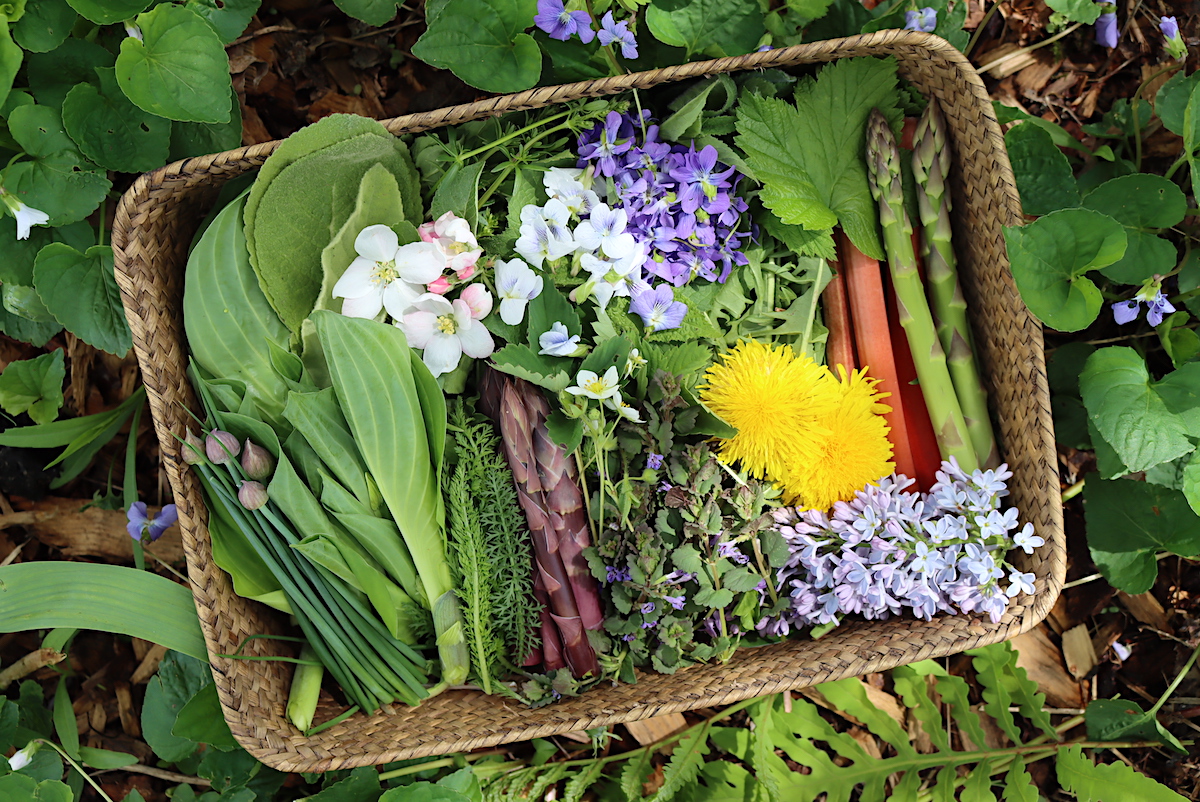
Spring is one of the most popular times of year for foraging, not necessarily because it’s the best time for harvesting wild food (but there is plenty). It’s more that everyone’s looking for an excuse to get outside, and harvesting a quick salad from the edge of your lawn is a great way to have a bit of fun, practice your skills, and get outside after a long winter indoors.
Certain things, like common edible weeds, are at their peak this time of year, but spring foraging goes way beyond dandelions and wild violets. There is so much you can harvest this time of year!
I’ve put together a list of more than 100 wild edible plants and mushrooms that are in season in spring, well beyond the basics of simple spring foraging. If you’re looking for more options and creative ways to sprice up your meals with wild food, there’s plenty to find!
I’ve covered commonly known wild spring edible plants like dandelions, ramps and wild asparagus, to more obscure finds that are still plentiful in nature, but few people know that they’re edible and useful. Greens, roots, seeds, flowers, fruits, mushrooms, and even a few edible lichen species. There’s plenty to find, and this list has something for beginners and adventurous foragers alike.
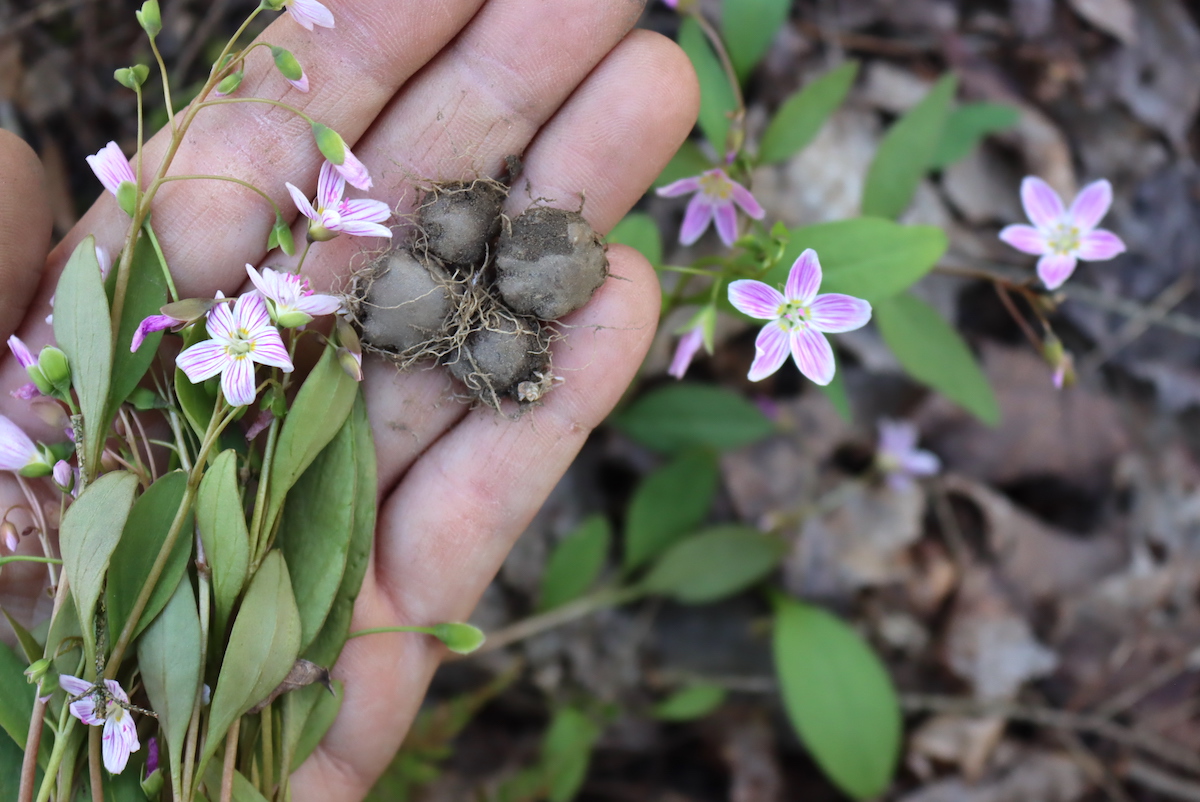
Spring Foraging
There’s so much for a forager to find in the spring months that I’ve broken the list into sections. Some have multiple edible parts, and where they’d fall into multiple categories, I’ve gone with the most common use.
For example, dandelion has edible flowers, leaves, roots, and seeds, but the most commonly eaten part of the plant is dandelion greens, you’ll find it listed with the spring greens.
Here’s how the list is divided:
- Edible Spring Greens
- Spring Woodland Ephemerals
- Roots and Tubers
- Edible Trees
- Edible Seeds and Grains
- Wild Fruit & Nuts
- Pond, Bog, and Water Plants
- Spring Mushroom Foraging
- Medicinal Plants
Edible Spring Greens
Wild spring greens are some of the easiest to forage, especially for beginning foragers. You can find many of these growing in the average suburban lawn, along walking paths, roads, or parking lots, even in suburban and urban areas.
These truly are the most accessible options if you want to get out there this spring!
- Bittercress (Cardamine hirsuta)
- Bugleweed (Ajuga sp.)
- Chickweed (Stellaria media)
- Claytonia (Claytonia perfoliata)
- Cleavers (Galium aparine)
- Dandelion (Taraxacum officinale)
- Evening Primrose (Oenothera biennis)
- Garlic Mustard (Alliaria petiolata)
- Ground Ivy (Glechoma hederacea)
- Henbit (Lamium amplexicaule)
- Foraging Horsetail (Equisetum sp.)
- Lambsquarter (Chenopodium album)
- Marsh Marigold (Caltha palustris)
- Plantain (Plantago sp.)
- Purple Dead Nettle (Lamium purpureum)
- Purslane (Portulaca oleracea)
- Red Clover (Trifolium pratense)
- Self Heal (Prunella vulgaris)
- Shepherd’s Purse (Capsella bursa-pastoris)
- Speedwell (Veronica sp.)
- Stinging Nettles (Urtica Diocia)
- Wild Violets (Viola sp.)
- White Clover (Trifolium repens)
- Wintercress or Yellow Rocket (Barbarea vulgaris)
- Wood Sorrel (Oxalis sp.)
- Yarrow (Achillea millefolium)
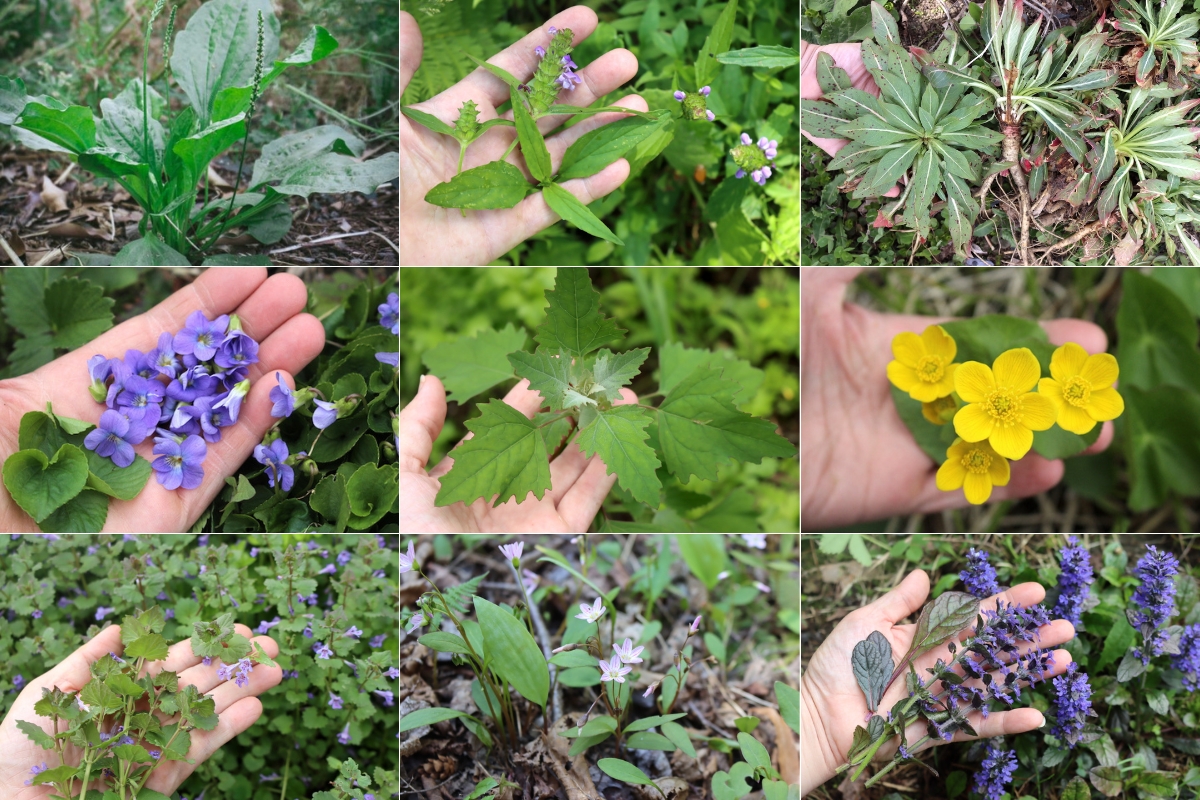
Edible Spring Flowers
Many of the wild edible spring weeds listed above also have edible flowers, and the edible trees section also includes trees with edible flowers as well. Dandelions, for example, are edible from blossom to root and it’s listed with wild weeds. For trees, Redbud is a well-known spring edible flower, but the leaves and bark are also edible (it’s listed with trees).
These plants, in particular, happen to have edible flowers, but the flower is the only thing ready for harvest in the spring. If the greens, bark, roots, or other parts are edible as well, they’re listed elsewhere.
- Forsythia
- Fruit Tree Blossoms (Apple, Crabapple, etc)
- Magnolia
- Mimosa
- Staghorn Sumac
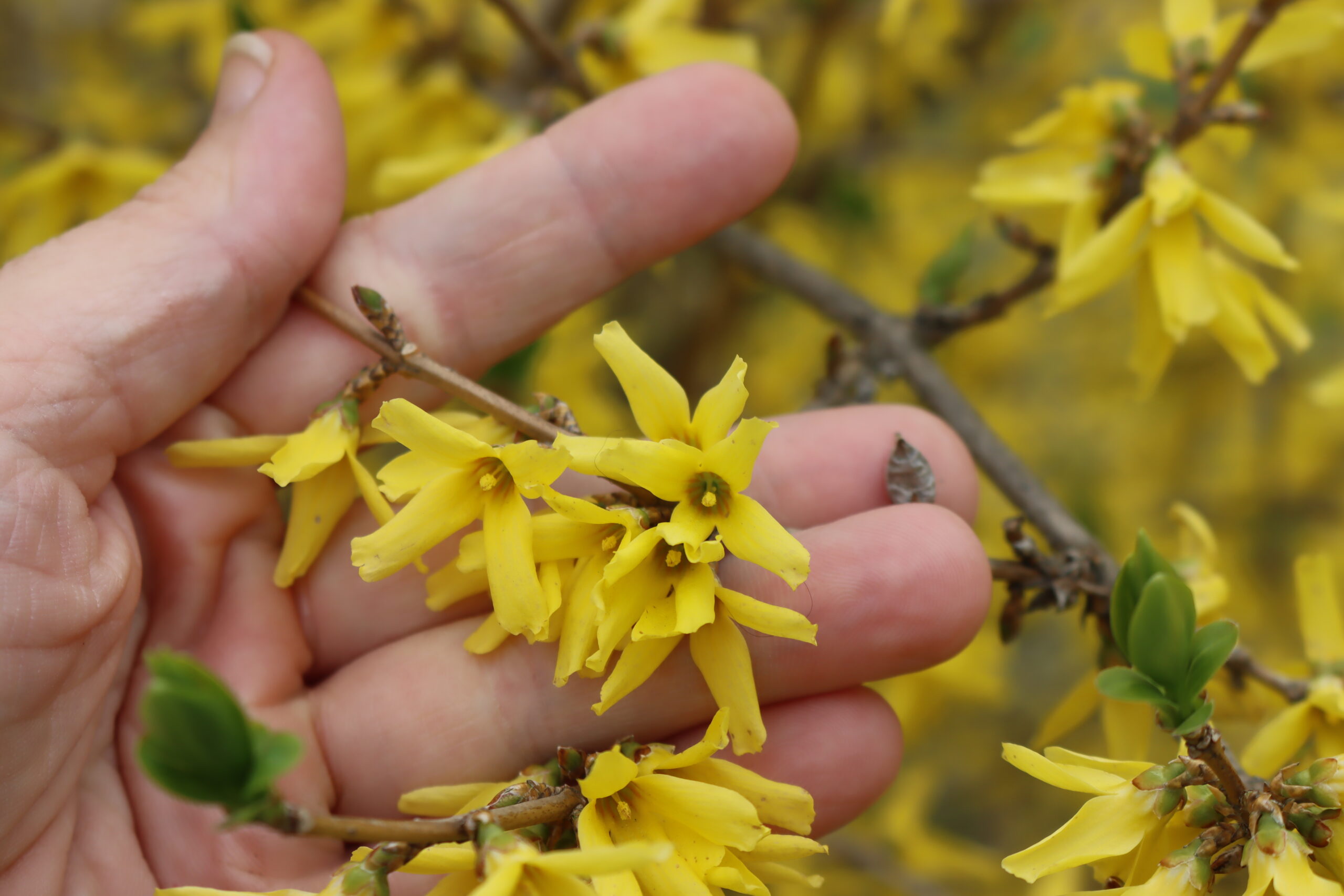
Spring Shoots & Ephemerals
Spring ephemerals are a specific class of plant that is only visible for a short period in the early spring, usually before the trees leaf in above them in a woodland. They’re especially prized by foragers since they’re only available for a few weeks before the plants go dormant again for the rest of the year.
Beyond ephemerals, I’ve also included spring shoots, or plants that are eaten when the young shoots are only a few inches tall each spring. They’re not “ephemeral” in a technical botanical sense, as the plants are there all season, but the harvest window for these shoots is short-lived.
- Carrion flower (Smilax rotundifolia) – Spring Shoots
- Ramps or Wild leeks (Allium tricoccum) – Ephemeral
- Fiddlehead Ferns (Matteuccia struthiopteris) – Spring Shoots
- Japanese Knotweed (Reynoutria japonica) – Spring Shoots
- Milkweed (Asclepias syriaca) – Spring Shoots
- Spring Beauty (Claytonia lanceolata)
- Thimbleberry (Rubus sp.) – Spring New Growth Shoots
- Wild Grape (Vitis sp.) – Shoots, Leaves & Tendrils
- Wild Asparagus (Asparagus acutifolius) – Spring Shoots
Wild Roots and Tubers
Taproots and tubers are one way that plants fuel their new spring growth, and in early spring, these roots are full of sugar and calories. Those sugars go into fueling the plant for fast spring growth in its second year, and early spring is the perfect time to harvest these plants.
As soon as they start growing in the early spring, you can identify the plants by their tops (or by the dried remnants of last year’s plant). As always, be sure of your identification!
- Bull Thistle (Cirsium vulgare)
- Burdock (Arctium sp.)
- Cattails (Typha sp.)
- Chickory (Cichorium intybus)
- Chufa (Cyperus esculentus)
- Dandelion (Taraxacum officinale)
- Daylily (Hemerocallis sp.)
- Dock, Yellow or Curly (Rumex sp.)
- Evening Primrose (Oenothera sp.)
- Ground Nut or Hopniss (Apios americana)
- Lesser Celandine (Ficaria verna)
- Lotus, American (Nelumbo lutea)
- Mullein (Verbascum thapsus)
- Ramps or Wild Leeks (Allium tricoccum)
- Spring Beauty (Claytonia lanceolata)
- Solomon’s Seal (Polygonatum sp.)
- Sunchokes or Jerusalem Artichokes (Helianthus tuberosus)
- Trout Lily (Erythronium pudica)
- Wild Carrot or Queen Anne’s Lace (Daucus carota)
- Wild Parsnip (Pastinaca sativa)
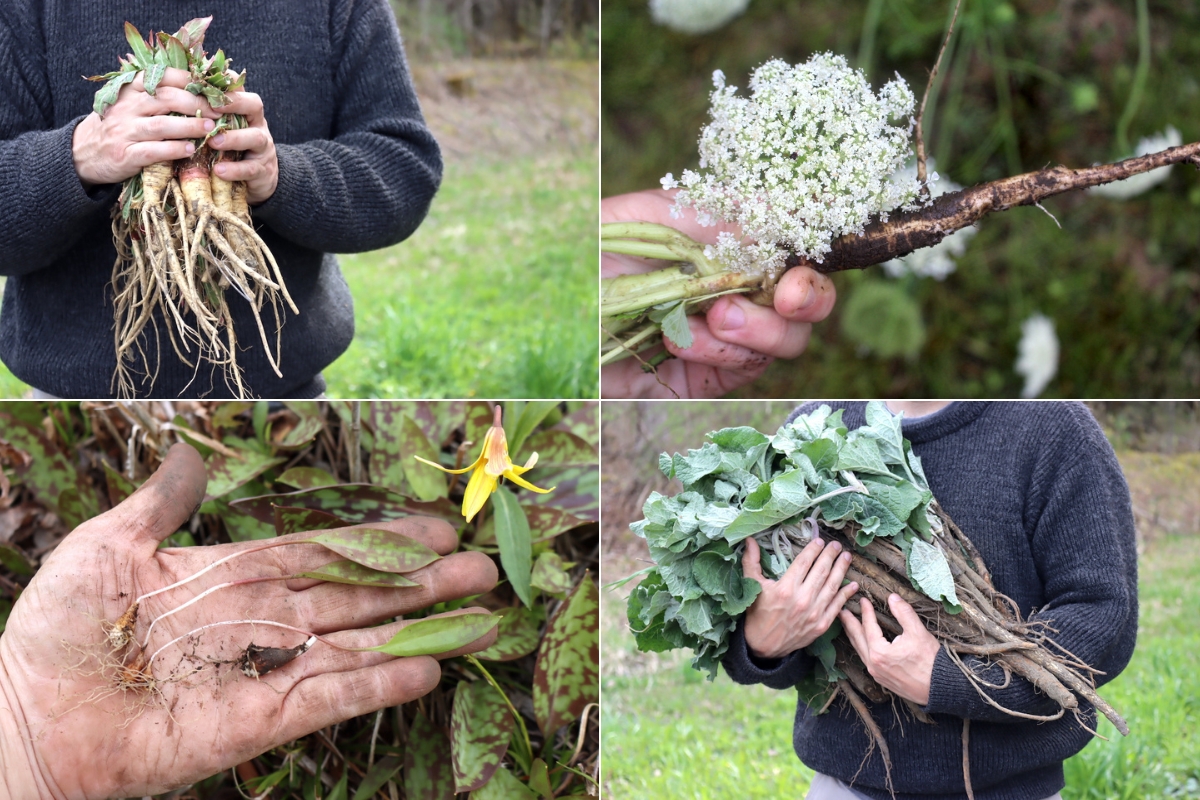
Edible Trees & Shrubs
In a rush to harvest the spring weeds beneath our feet, we often miss the tender leaves, shoots, and flowers on the trees above us. The new leaves of many species of tree are delicious, and common yard (and woodland) trees like maple and linden have especially succulent spring leaves.
Beyond their leaves, many trees have shoots or tips that are edible, like well known spruce tips, but other conifers have edible tips as well.
Flowering trees like redbud are an extra special treat, as they’ll be covered in sweet blossoms.
And of course, there’s always tree species with edible sap, which you can drink as is, or boil into syrup. This goes well beyond maples, and there are at least 27 Tree Species that you can Tap for Syrup.
Many trees also have edible bark, which can be surprisingly tasty, but you have to be careful here as harvesting can damage the tree.
- Birch (Betula sp.)
- Linden (Tilia sp.)
- Maple (Acer sp.)
- Pine (Pinus sp.)
- Redbud (Cercis canadensis)
- Spicebush (Lindera benzoin)
- Spruce Tips (and Other Conifer Tips)
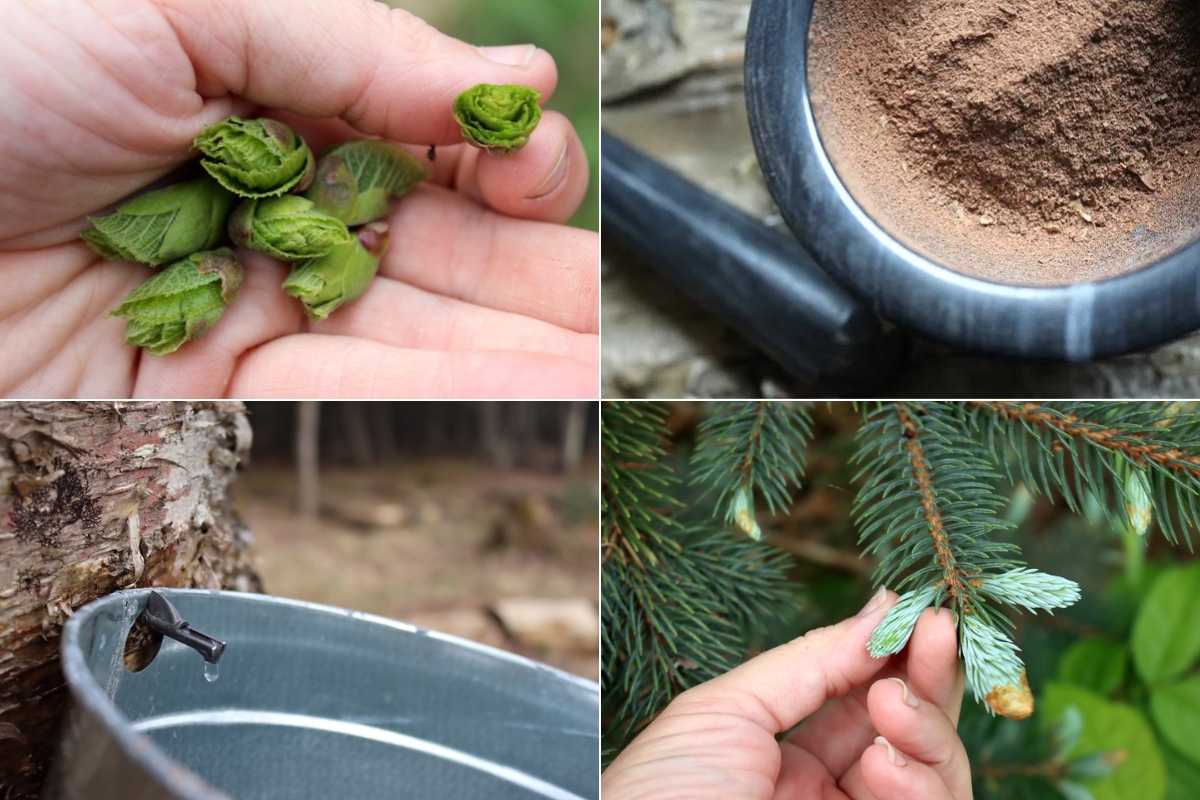
Edible Seeds and Grains
Most foragers don’t realize just how many wild edible seeds and grains there are to be found year-round. Many of these were foraged as staple crops historically, and bog bodies have been found with bellies full of wild edible grains.
These days, with modern agriculture, we tend to skip over these grains as not worth the effort. It’s a shame, as they were well worth it back when our ancestors depended on them for survival.
Some of these plants develop seeds early, like dandelions, but others are simply harvested dry on the stalk, preserved from the autumn before. I’ve harvested all of these wild seeds in the late winter and early spring months:
- Amaranth (Amaranthus sp.)
- Chickweed (Stellaria media)
- Claytonia (Claytonia perfoliata)
- Dandelion (Taraxacum officinale)
- Dock Seeds (Rumex sp.)
- Evening Primrose (Oenothera sp.)
- Goosefoot Seed or Wild Quinoa (Chenopodium album)
- Hop Hornbeam (Ostrya sp.)
- Mallow (Malva sp.)
- Plantain (Plantago sp.)
- Queen Anne’s Lace (Daucus carota)
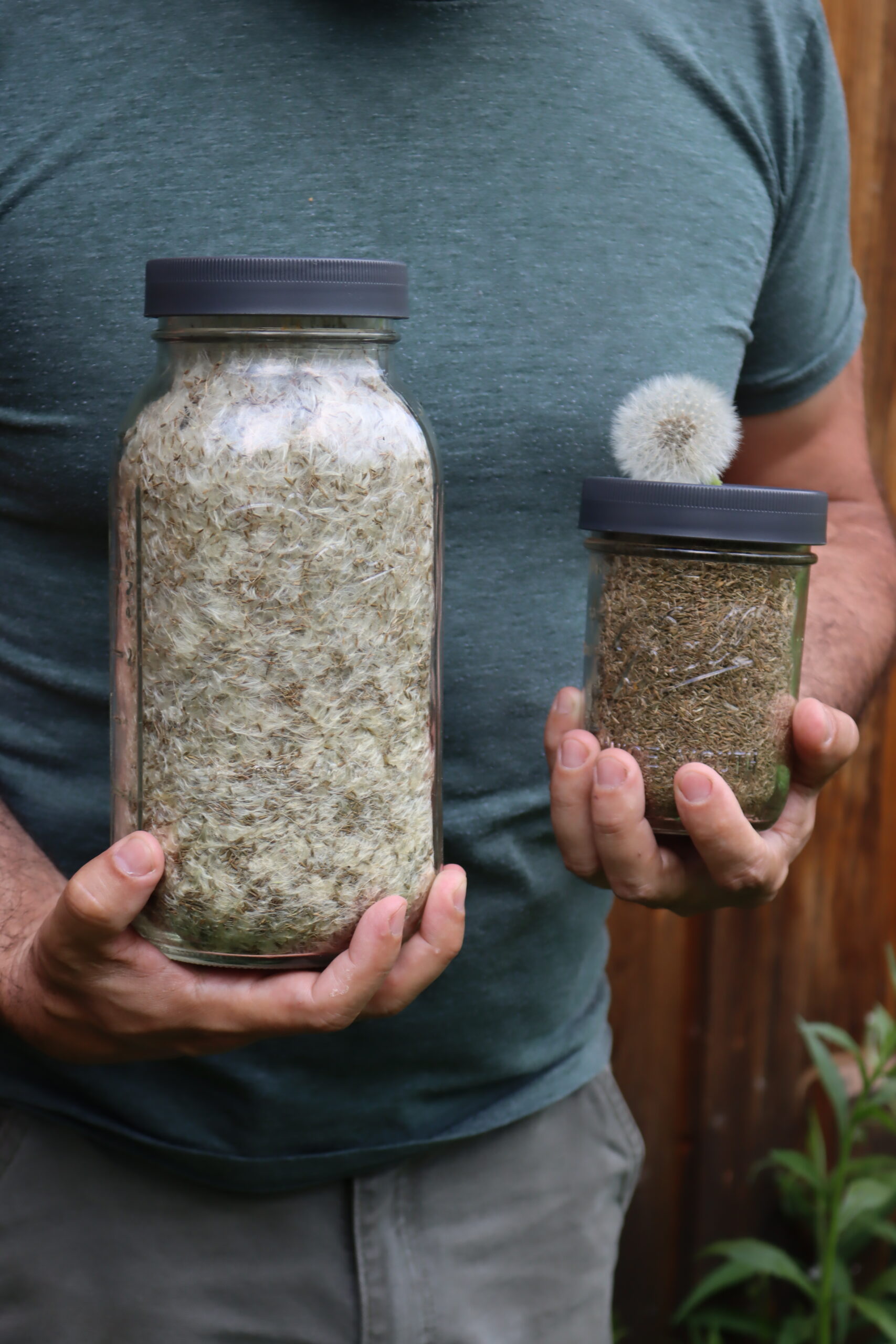
Wild Fruit and Nuts
Most fruits don’t ripen until at least early summer, but there are a few exceptions. Honeyberries are incredibly early, and we’ll see them in Late spring here in Vermont (and earlier in warmer locations). The same goes for wild strawberries.
Most spring fruit, however, is simply held over from last autumn, frozen on the plant, and neatly preserved for spring foraging. Groundcovers like teaberry and partridgeberry are abundant each spring, as are cranberries. They hide beneath a blanket of snow all winter.
Others just ripen late, like nannyberry and highbush cranberry. The birds have already migrated for the year, but they’ve evolved to stay good all winter and feed the returning flocks come spring. They can be harvested in early spring as well.
- Cranberry (Vaccinium sp.)
- Hazelnuts (Corylus sp.)
- Highbush Cranberry (Viburnum edule)
- Honeyberry or Haskap (Lonicera caerulea)
- Nannyberry (Viburnum lentago)
- Partridgeberry (Mitchella repens)
- Teaberry (Gaultheria procumbens)
- Wild Strawberry (Fragaria sp.)

Pond, Bog, and Water Plants
Normally, I save water and pond foraging for the warm summer months, but this spring, I went wading for Lotus and cattail in April in Vermont. Shallow water warms quickly, especially if you have a warm spring, and even in cold years, it’s still fun for quick excursions.
These plants are available in and around ponds or wetlands in the spring months:
- Arrowhead or Duck Potato (Sagittaria latifolia)
- Cattail (Typha latifolia)
- Lotus (Nelumbo lutea)
- Sweet Flag (Acorus calamus)
- Watercress (Nasturtium officinale)

Spring Mushroom Foraging
Morels are one of the best-known spring mushrooms, but there’s so much more out there to harvest if you know where to look. Many of these mushroom species can be harvested all winter long, even in cold climates, and they’re still out there, ready for you to find them in the spring. That includes wild winter mushrooms like Birch Polypore, Chaga, Tinder Polypore, Turkey Tail, Witches Butter, and Wood Ear.
Others appear in spring as soon as soil and wood temperatures begin to warm. Those include morels, chicken of the woods, reishi and more.
Still others are only spring mushrooms in the right climate, like Yellowfoot or “winter” chanterelles. In the Northeast, they’re a mid-summer mushroom, but in the Pacific Northwest, they’re harvested in late winter and early spring.
- Birch Polypore (Fomitopsis betulina)
- Boletes (Boletus sp.)
- Chanterelle Mushrooms (Cantharellus sp.)
- Chicken of the Woods Mushroom (Laetiporus sulphureus)
- Dryad’s Saddle (Cerioporus squamosus)
- Morel Mushrooms (Morchella sp.)
- Reishi Mushrooms (Ganoderma sp.)
- Shaggy Mane Mushrooms (Coprinus comatus)
- Tinder Polypore (Fomes fomentarius)
- Turkey Tail Mushrooms (Trametes versicolor)
- Velvet Foot or Wild Enoki (Flammulina velutipes)
- Winter Chanterelles or Yellowfoot Chanterelles (Cantharellus sp.)
- Witches Butter Mushrooms (Dacrymyces palmatus)
- Wood Ear Mushrooms (Auricularia sp.)
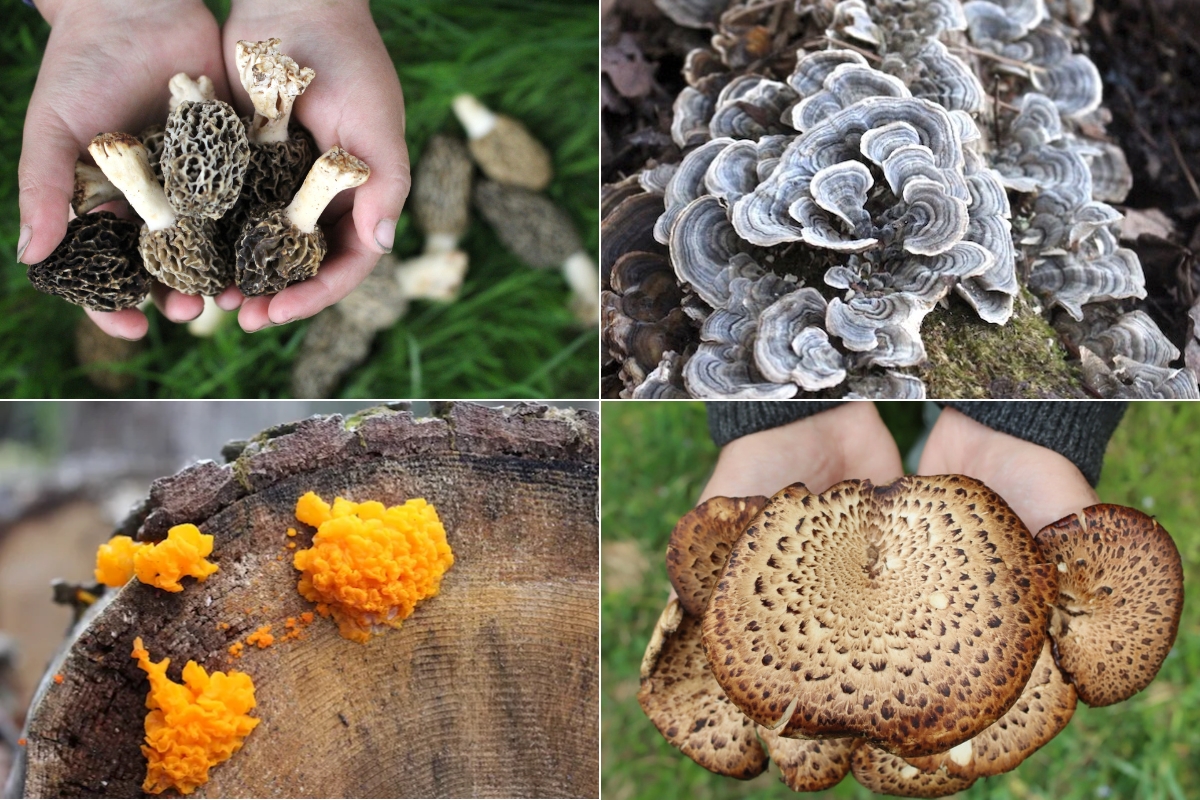
Spring Wild Medicinal Plants
Many of the plants listed above also happen to be medicinal, but for the most part, they’re harvested for food first (and medicine is just a byproduct rather than the original intention). These plants are not generally considered food plants, but they are eaten in the form of medicine.
You’re not getting a lot of calories here, and doses are usually small quantities. Still, they’re incredibly valuable if and when you need them!
- Barberry (Berberis vulgaris) – Roots are harvested medicinally.
- Bloodroot (Sanguinaria canadensis)
- Comfrey (Symphytum officinale) – Roots are harvested medicinally. Most sources suggest sticking to external uses only, since even small doses may be toxic, though it has a history of internal use historically.
- Elecampane (Inula helenium) – We use this for homemade cough syrup, and I personally find it extremely effective.
- Horsetail (Equisetum sp.)
- Marshmallow (Althaea officinalis) – Marshmallow root tea is incredibly soothing for sore throats and cough, and I keep it on the shelf for winter remedies.
- Mullein (Verbascum thapsus) – I use the leaves and flowers, and only recently learned the root is used medicinally as well.
- Japanese Knotweed (Reynoutria japonica) – The root is traditionally used for Lyme disease.
- Trillium (Trillium sp.)
- Usnea Lichen (Usnea sp.)
- Valerian (Valeriana Officinalis) – Used as a sleep aid, often as a herbal tincture.
- Wild Ginger (Asarum canadense) – Small doses, and use caution as it may be toxic.
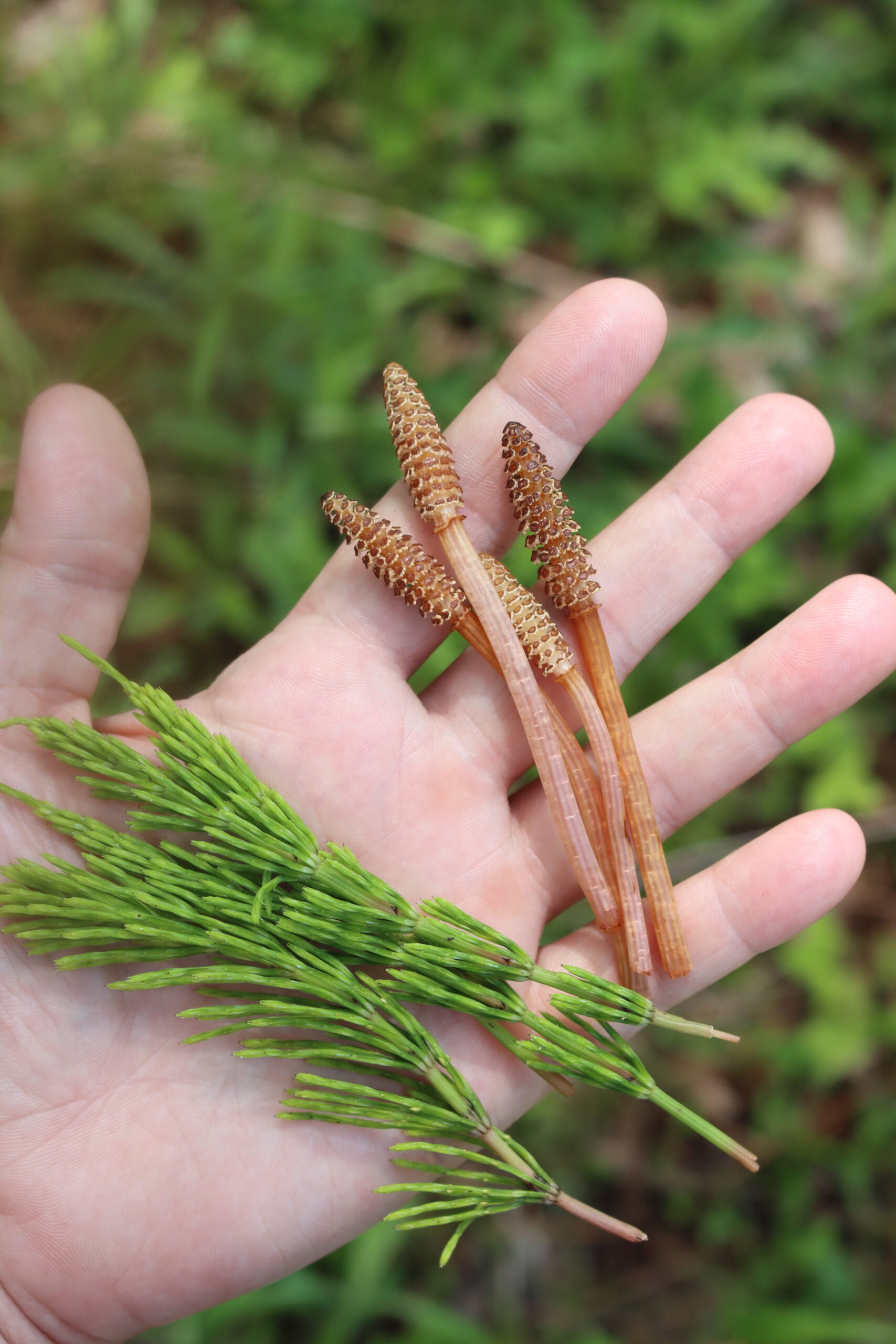
Foraging Lists
Looking for more lists of wild edible plants to fuel your foraging passion?
- 13+ Edible Wild Mushrooms for Beginners
- 20+ Edible Weeds in Your Garden
- 60+ Edible Wild Fruits and Berries
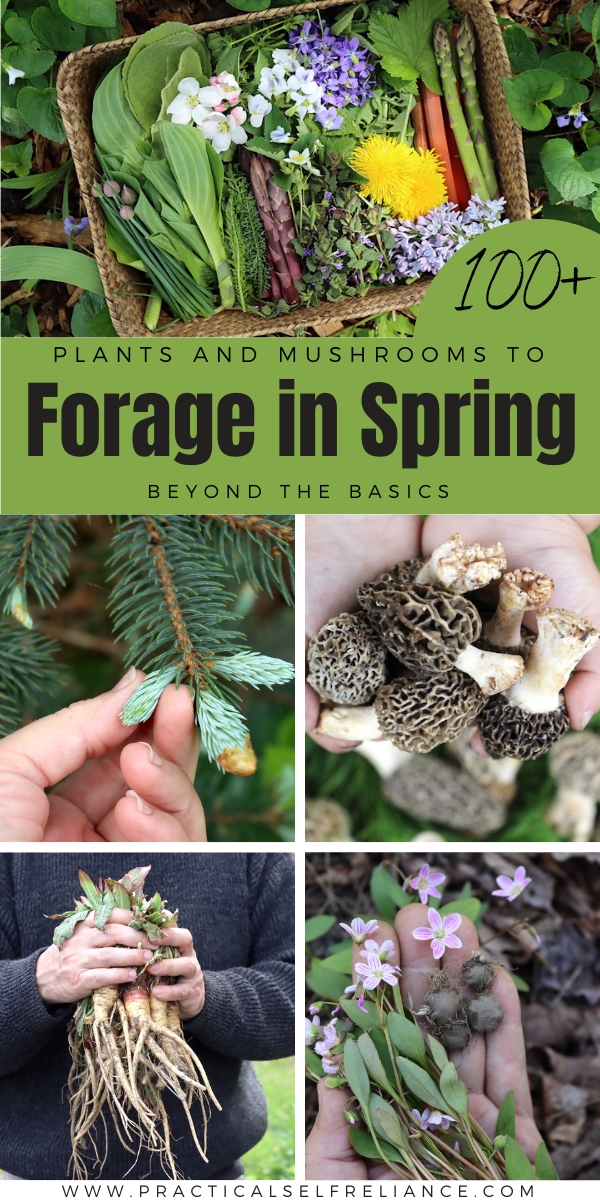




Excellent and rich list. One of the best i’ve ever seen. Great job!